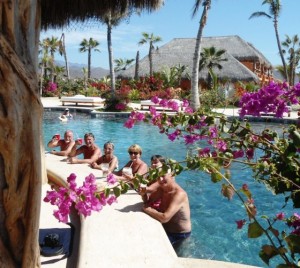
February 26, 2014 – Well we arrived in La Paz yesterday after a couple of days on the Pacific at the Los Cerritos Surf Colony RV Park. This would be a parking lot thinly disguised as some kind of campground. The bonus is access to the pool, WiFi, flush toilets, bar and restaurant. The downside is a dusty parking lot without even garbage cans and an escalating fee that has chased all other customers away. What started out as a popular but expensive boondocking location for many RVs has become an empty parking lot, not sure how Roger Pollock is making money like this?

Back to La Paz –After fueling and a short stop at Walmart for a few items we headed to Campestra Maranatha and got settled in. After lunch we headed off to the La Paz Malecon, Ibarra’s Pottery, the overlook of the La Paz Panteon and a waterfront drive. Later that evening we headed for Los Magueyes Restaurant, a very popular local eatery for sure. Everyone enjoyed their meal immensely including the Flaming Flan. As we drove along the Malecon you could see they were getting setup for Carnaval which starts in a couple of days.

Our last day in Cabo San Lucas began with a swim at Playa Santa Maria. The water was wonderful, the whales easy to see from shore and a local was trying out the newest gadget called a Cabo Flyboard. The vendors were out as well, sales were brisk. After lunch some folks were dropped off at the Puerto Paraiso Mall for a walkabout and later we hosted a Happy Hour on Playa Medano, lots of fun, vendors and sales. Victor showed up and sold some lemon wood pots, folks always like these. Judy hitched a ride with a young Mexican lad for a spin around the bay on a jetski, she really had a thrill! That evening Mike & Kelly joined us for a nightcap as did Dom & Diane on their return from dinner at Vag’s. What a noisy bunch 🙂!

The next morning the six (6) of us met for breakfast at the Villa Serena Restaurant and decided Mike & Kelly were great picks as our Baja Amigos American Sales Team. Then we were off to west coast and Los Cerritos with a stop along the way at Afren’s Blanket Factory. After some bargaining and a few purchases we headed off to our destination. That evening we hosted a dinner at La Pasadita, Jose and his family always do a wonderful job serving the grub. Bobby and his son Chandler were able to join us. Everyone really did enjoy the pool and swim at bar at the Los Cerritos Surf Colony, the beach was a real hit as well.
Today we head off for our walkabout of La Paz starting with the Fransisco Madero Mercado.
Did you know?

The President of the United Mexican States (Spanish: Presidente de los Estados Unidos Mexicanos) is the head of state and government of Mexico. Under the Constitution, the president is also the Supreme Commander of the Mexican armed forces. The current President is Enrique Peña Nieto, who took office on December 1, 2012. Currently, the office of the President is considered to be revolutionary, in that the powers of office are derived from the Revolutionary Constitution of 1917. Another legacy of the Revolution is its ban on re-election. Mexican presidents are limited to a single six-year term, called a sexenio. No one who has held the post, even on a caretaker basis, is allowed to run or serve again. The constitution and the office of the President closely follow the presidential system of government.

Requirements to hold office
Chapter III of Title III of the Constitution deals with the executive branch of government and sets forth the powers of the president, as well as the qualifications for the office. The President is vested with the “supreme executive power of the Union.”
To be eligible to serve as president, Article 82 of the Constitution specifies that the following requirements must be met:
- Be a natural-born citizen of Mexico (“mexicano por nacimiento“) able to exercise full citizenship rights, with at least one parent who is a natural-born citizen of Mexico.
- Be a resident of Mexico for at least twenty (20) years.
- Be thirty-five years or older at the time of the election.
- Be a resident of Mexico for the entire year prior to the election (although absences of 30 days or fewer are explicitly stated not to interrupt residency).
- Not be an official or minister of any church or religious denomination.
- Not be in active military service during the six months prior to the election.
- Not be a secretary of state or under-secretary of state, attorney general, governor of a State, or head of the government of the Federal District, unless “separated from the post” (resigned or been granted permanent leave of absence) at least six months prior to the election.
- Not have been president already, even in a provisional capacity (see Succession below).·
Presidential powers

The 1917 Constitution borrowed heavily from the Constitution of the United States, providing for a clear separation of powers while giving the president wider powers than his American counterpart. However, this has only recently become the case in practice. For the first 71 years after the enactment of the 1917 Constitution, the president exercised nearly absolute control over the country. Much of this power came from the de facto monopoly status of the PRI. As mentioned above, he effectively chose his successor as president by personally nominating the PRI’s candidate in the next election. In addition, the unwritten rules of the PRI allowed him to designate party officials and candidates all the way down to the local level. He thus had an important (but not exclusive) influence over the political life of the country (part of his power had to be shared with unions and other groups, but as an individual he had no peers). This, and his constitutional powers, made some political commentators describe the president as a six-year dictator, and to call this system an “imperial presidency”. The situation remained largely unchanged until the early 1980s, when a grave economic crisis created discomfort both in the population and inside the party, and the president’s power was no longer absolute but still impressive.

An important characteristic of this system is that the new president was effectively chosen by the old one (since the PRI candidate was assured of election) but once he assumed power, the old one lost all power and influence (“no re-election” is a cornerstone of Mexican politics). In fact, tradition called for the incumbent president to fade into the background during the campaign to elect his successor. This renewed command helped maintain party discipline and avoided the stagnation associated with a single man holding power for decades, prompting Peruvian novelist Mario Vargas Llosa to call Mexico’s political system “the perfect dictatorship”, since the president’s powers were cloaked by democratic practice.

With the democratic reforms of recent years and fairer elections, the president’s powers have been limited in fact as well as in name. Vargas Llosa, during the Fox administration, called this new system “The Imperfect Democracy”. The President’s current powers and rights include the following:
- The right to appoint the Attorney General
- The right to appoint the Attorney General and the Chief of Police of the Federal District
- The right to appoint the Secretaries of State and all the members of the Mexican Executive Cabinet
- The right to appoint all Mexican Ambassadors
- Supreme power over the army, navy, and air force
- The power to declare war and peace (with prior congressional authorization)
- The power of negotiating foreign treaties
- The power to issue decrees
- The right to nominate Supreme Court justices
- The power to veto laws (and, after a Supreme Court ruling about the controversial 2004 budget, also the power to veto decrees from Congress).
- The right to introduce bills in Congress for their consideration.

A decree is a legislative instrument that has an expiration date and that is issued by one of the three branches of government. Congress may issue decrees, and the President may issue decrees as well. However, they have all the power of laws, but cannot be changed except by the power that issued them. Decrees are very limited in their extent. One such decree is the federal budget, which is issued by congress. The president’s office may suggest a budget, but at the end of the day, it is congress that decrees how to collect taxes and how to spend them. A Supreme Court ruling on Vicente Fox’s veto of the 2004 budget suggests that the President may have the right to veto decrees from Congress.

Since 1997, the Congress has been plural, usually with opposition parties having a majority. Major reforms (tax, energy) have to pass by Congress, and the ruling President usually found his efforts blocked: the PRI’s Zedillo by opposing PAN/PRD congressmen, and later the PAN’s Fox by the PRI and PRD. The PAN would push the reforms it denied to the PRI and vice-versa. This situation, novel in a country where Congress was +90% dominated by the president’s party for most of the century, has led to a legal analysis of the president’s power. Formerly almost a dictator (because of PRI’s party discipline), the current times show the president’s power as somewhat limited. In 2004, President Fox threatened to veto the budget approved by Congress, claiming the budget overstepped his authority to lead the country, only to learn no branch of government had the power to veto a decree issued by another branch of government (although a different, non jurisprudence-setting ruling stated he could return the budget with observations).



